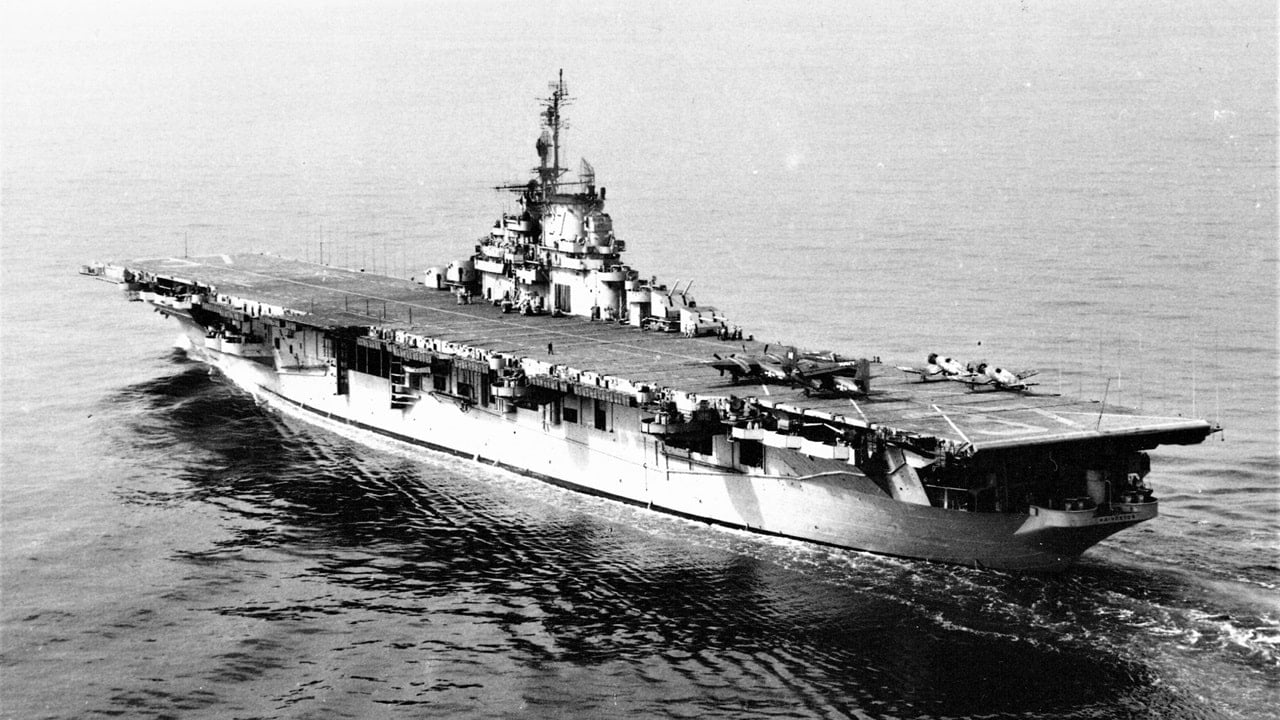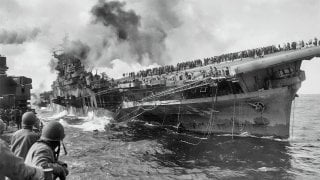USS Franklin: The Navy Aircraft Carrier Called 'The Warship That Wouldn't Die'
The USS Franklin (CV-13), an Essex-class aircraft carrier, was commissioned in 1944 and saw significant action in the Pacific during WWII.
Summary and Key Points: The USS Franklin (CV-13), an Essex-class aircraft carrier, was one of the most decorated ships in U.S. Navy history. Commissioned in January 1944, it participated in numerous World War II Pacific campaigns. The carrier endured severe attacks, including kamikaze strikes and bomb hits, causing significant casualties.

-Despite being heavily damaged and nearly abandoned, the ship's crew heroically saved it, earning the nickname "The Ship That Wouldn't Die."
-The Franklin's crew received numerous awards, including two Medals of Honor. After the war, the ship was decommissioned and never returned to active service, marking a notable chapter in naval history.
The Indomitable USS Franklin: The Ship That Wouldn't Die
Twenty-four Essex-class aircraft carriers were built for the U.S. Navy during World War II, and only two did not continue their service during the Cold War. One of those was the USS Franklin (CV-13). The ship received numerous awards, including four battle stars for service. Meanwhile its sailors become one of the most decorated crews in Navy history.
What makes this all the more notable is that the Essex-class carrier was only commissioned on January 31, 1944. Deployed to the Pacific, CV-13 took part in the Mariana Islands Campaign, providing air support during amphibious landings on the Bonin Islands, Guam, and the Palau Islands, among others. The carrier took part in the Battle of Leyte Gulf and on October 30, 1944, was attacked by Japanese kamikazes, which struck the flight deck.
Back to Action
After being repaired at the Puget Sound Navy Yard in Bremerton, Washington, the USS Franklin – nicknamed "Big Ben" by her crew – returned to service and joined Task Force 58 in March 1945. The carrier was supporting air attacks on the Japanese home islands in support of the landings on Okinawa when on March 19, she came under attack from a Japanese bomber that closed on the flattop and dropped two 550-pound semi-armor-piercing bombs. The first bomb struck the flight deck, exploding on impact and tragically killing nearly all the crewmembers located at the forward part of the hangar deck.
A second bomb also struck the flight deck, igniting a series of fires that engulfed the warship and its aircraft. At the time the bombs were dropped, the carrier had 31 armed and fueled aircraft warming up on her flight deck, while the hangar deck contained an additional 22 planes – with 16 also fueled, and five armed. The bombs set off a series of explosions of ordnance, setting off general purpose bombs, "Tiny Tim" rockets, and aviation fuel. Just two crewmen in the hangar deck survived.
That wasn't the last of it. The initial attack was followed up by seemingly relentless waves of Japanese aircraft that included a reported five more bombers, 14 torpedo planes, and a dozen fighters. Big Ben was clearly a big prize for the Imperial Japanese Navy. The ship was essentially dead in the water just 50 miles off the coast of Japan. It listed as much as 13 degrees to starboard.
The "Lucky 13"
The ship lost all radio communications. Much of her crew – those that weren't blown overboard, killed, or wounded – continued valiantly to save the warship. Though Captain Leslie E. Gehres, commanding officer of the USS Franklin, was advised to issue an abandon ship order, he did not – Gehres believed the ship could be saved. Despite the relentless attacks, CV-13 proved to have luck on her side and survived, earning a reputation as "The Ship That Wouldn't Die."

However, the ship’s survival came at a tragically high price, with 796 killed and 265 wounded. Combined with those killed on October 30, 1944, during the kamikaze attack, the USS Franklin had 924 of its crew killed – the highest count of any U.S. ship in the Second World War except for the USS Arizona (BB-39), which was sunk at Pearl Harbor on December 7, 1941.
Lieutenant Commander Joseph T. O'Callahan, the ship's Catholic chaplain, and Lieutenant Donald A. Gary, were each awarded the Medal of Honor for their heroic efforts in attending to the wounded and saving numerous lives, while an additional 19 Navy Crosses, 22 Silver Stars, 116 Bronze Stars, and 235 Letters of Commendation were issued to the crew. In total, the U.S. Navy awarded 808 posthumous Purple Hearts, along with 347 Purple Hearts to the survivors.
As noted, the crew of the USS Franklin was the most decorated in U.S. Navy history, and they truly earned their awards.
The carrier was undergoing repairs when the war ended, and she was sent to the Atlantic Reserve Fleet. Though redesignated an attack aircraft carrier (CVA-13), an antisubmarine warfare support carrier (CVS-13), and finally an aircraft transport (AVT-8), she never returned to active service.
Along with the USS Bunker Hill (CVN-17), also damaged in a kamikaze attack, the USS Franklin was just one of two U.S. Navy Essex-class carriers never to return to action. It could be said the warship earned her retirement, and proved the Essex class was essentially unsinkable.
Author Experience and Expertise: Peter Suciu
Peter Suciu is a Michigan-based writer. He has contributed to more than four dozen magazines, newspapers, and websites with over 3,200 published pieces over a twenty-year career in journalism. He regularly writes about military hardware, firearms history, cybersecurity, politics, and international affairs. Peter is also a Contributing Writer for Forbes and Clearance Jobs. You can follow him on Twitter: @PeterSuciu. You can email the author: [email protected].
The main image is of the USS Franklin. All others are images of Essex-Class Aircraft Carriers. All images are Creative Commons.


